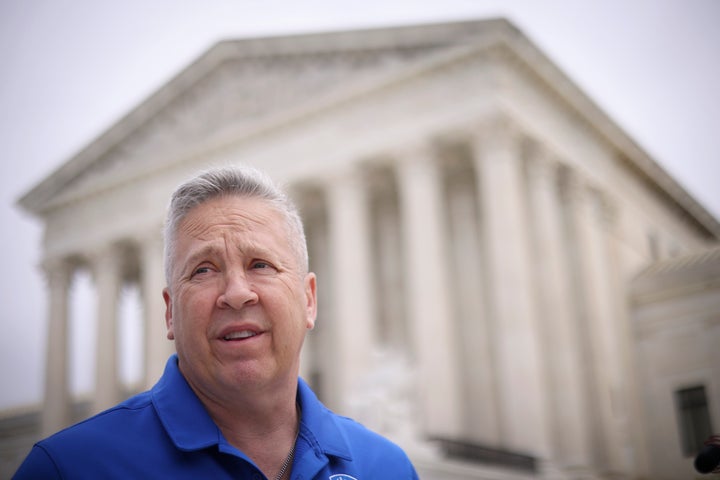This article is part of HuffPost’s biweekly politics newsletter: Click here to subscribe.
As if the conservatives on the Supreme Court weren’t busy enough rolling back abortion rights, scrutinizing century-old gun restrictions and undermining the federal government’s power to slow climate change, they may also be gearing up to strike yet another blow at the separation between church and state.
This week, the justices heard oral arguments in Kennedy v. Bremerton School District, a case about a Washington state high school football coach who led post-game prayers at the 50-yard-line, where student-athletes and other coaches would gather to worship with him.
School district officials said the prayers amounted to a form of state-sponsored religious expression. They told the coach, Joe Kennedy, he needed to pray on his own and away from the field — and offered to make arrangements for that.
Kennedy said the officials were infringing upon his right to practice his faith in what was, fundamentally, a private act for him and whoever decided to join. He held the prayers anyway and sued, with the backing of religious conservative groups.
The stakes are big. As HuffPost’s Paul Blumenthal explained in his writeup of the case, even a narrow ruling in favor of the coach could significantly shift the rules on school prayer, allowing for more overt and more public displays of faith on school grounds ― and during officially sanctioned activities ― than the Court has allowed previously.
It would also, as Blumenthal noted, be a “major victory for the Christian religious right,” which has spent decades trying “to put religious prayer back in schools.”
One concern about such a ruling is that it could put pressure on students who don’t share the predominant religious beliefs of their community, not to mention those who aren’t religious or don’t appreciate the government getting in the middle of religion in the first place. And this concern isn’t hypothetical.

The saga in Bremerton played out over several years, eventually turning into a media and political spectacle. During that time, according to a brief that the district’s lawyers filed, one parent told school district officials that their son felt “compelled to participate” because he thought it was necessary to secure playing time, while other parents said their kids “participated in the team prayers only because they did not wish to separate themselves from the team.”
It’s not clear how many students felt this way. It may have been a small handful — or even just one. But a big reason that the Supreme Court first banned teacher-led prayer back in 1962, and then spent several decades strengthening prohibitions on religious activity in schools, was to protect even tiny minorities on the theory that putting pressure on even just one student was putting pressure on one too many.
As Justice Elena Kagan put it during oral arguments, “what our cases have long cared about in thinking about these questions … is coercion on students and having students feel that they have to join religious activities that they do not wish to join.”
But Kagan is liberal and an Obama appointee. She doesn’t speak for the six conservative justices that Republican presidents put on the bench. And in the past, those conservative justices have taken a very different approach to church-state cases — one that sees the rights of religious Americans as under attack and in need of special protection.
Consider, for example, a 2020 case about temporary restrictions on public gatherings in order to prevent the spread of COVID-19. In that case, the justices ruled that the restrictions effectively punished the practice of religion, even though the limits on public gathering applied to a wide variety of settings and didn’t single out religious gatherings for special treatment.
The impulse to protect the religious from attack may sound familiar because it’s a piece of a broader argument that conservatives make all the time nowadays ― that their beliefs and way of life are under assault from a secular, “woke” elite that holds sway in politics, media, academia and (lately) even some corporate board rooms.
It’s also a little paradoxical, at least in the context of the school prayer case, given that the religious conservatives who feel so embattled have six conservative Supreme Court justices on their side — and, quite possibly, poised to hand them a big victory in this new case.
Which doesn’t mean victory for the coach and his allies is guaranteed. Virtually any outcome is possible, including a ruling sending the case back to lower courts to sort out lingering factual disputes over exactly what happened when.
But the smart money is still on a decision that would weaken the wall between church and state — a wall that, thanks to conservative justices, was already starting to falter.

